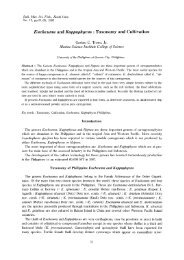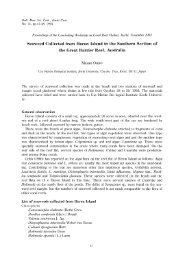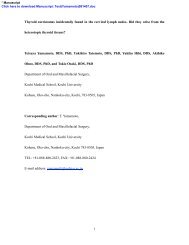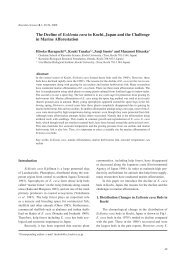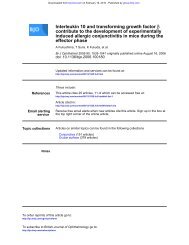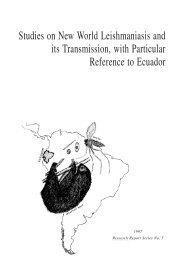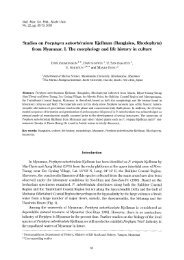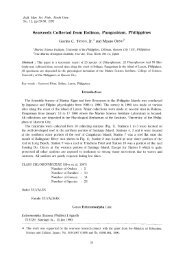Gauging English as a Lingua Franca in the Singapore Context
Gauging English as a Lingua Franca in the Singapore Context
Gauging English as a Lingua Franca in the Singapore Context
- No tags were found...
You also want an ePaper? Increase the reach of your titles
YUMPU automatically turns print PDFs into web optimized ePapers that Google loves.
<strong>Gaug<strong>in</strong>g</strong> <strong>English</strong> <strong>as</strong> a <strong>L<strong>in</strong>gua</strong> <strong>Franca</strong> <strong>in</strong> <strong>the</strong> S<strong>in</strong>gapore <strong>Context</strong>a text:produced language sensed or recorded by people and <strong>as</strong> such artifacts of <strong>the</strong> language culture.The concept here is drawn from Gee (1996, 2001) and functional systemics (see Halliday 1985).A text can be temporary (eg. spoken language texts <strong>in</strong> real time) or l<strong>as</strong>t<strong>in</strong>g (eg. written languagetexts, record<strong>in</strong>gs of temporary texts <strong>in</strong>clud<strong>in</strong>g transcriptions). Focus <strong>in</strong> this <strong>in</strong>vestigationnecessarily is l<strong>as</strong>t<strong>in</strong>g texts. A text-with-a-small-t is quantifiable and tangible, <strong>as</strong> dist<strong>in</strong>ct fromText-with-a-capital-T which relates to <strong>the</strong> l<strong>in</strong>guistic concept of Text.Language Culture:a culture def<strong>in</strong>ed by language behaviour characteristic of members of <strong>the</strong> community shar<strong>in</strong>g thisculture. Language culture is evident ma<strong>in</strong>ly, but not exclusively, <strong>in</strong> language texts which may beviewed <strong>as</strong> artifacts of <strong>the</strong> culture. This notion resembles <strong>the</strong> context of research on literacy eventsby Heath (1983)Language Community:a concept drawn from speech community (Roma<strong>in</strong>e 1994, see also Patrick 2002 for historiographicdiscussion of <strong>the</strong> speech community concepts), discourse community (Swales 1990) andcommunities of practice (Wenger 2006).Top-Down:<strong>in</strong> a hierarchical sense, referr<strong>in</strong>g to orig<strong>in</strong>s <strong>in</strong> <strong>in</strong>stitutions of government and <strong>as</strong>sociated entities at<strong>the</strong> top of a communityBottom-Up:orig<strong>in</strong>at<strong>in</strong>g from members of or elements at different levels with<strong>in</strong> <strong>the</strong> community withoutaffiliations with <strong>in</strong>stitutions at <strong>the</strong> Top<strong>L<strong>in</strong>gua</strong> <strong>Franca</strong> <strong>in</strong> a language community and its culture:An LF is <strong>the</strong> ma<strong>in</strong> or common language mode customarily used for written or spoken communicationamong members of <strong>the</strong> community. Features of an LF may <strong>in</strong>clude• may be evident <strong>as</strong> spoken or written modes but a more maturely developed language culturewould <strong>in</strong>cur both.• a non-established language variety - a de facto function<strong>in</strong>g language “… without a completeset of conversational <strong>in</strong>ferenc<strong>in</strong>g strategies found <strong>in</strong> established (language) varieties” (Firth1990 cited by van Horn 2009 p 630)• be<strong>in</strong>g “… an <strong>in</strong>termediary or contact language …; … language of commerce (or similartransactions) … a medium of communication stabilized without much <strong>in</strong>dividual variation” (B.©InternationalStudies, Faculty of Humanities& Economics,Kochi University
<strong>Gaug<strong>in</strong>g</strong> <strong>English</strong> <strong>as</strong> a <strong>L<strong>in</strong>gua</strong> <strong>Franca</strong> <strong>in</strong> <strong>the</strong> S<strong>in</strong>gapore <strong>Context</strong>AIMS OF THE SYLLABUSAt <strong>the</strong> end of <strong>the</strong>ir primary and secondary education, pupils will be able to communicateeffectively <strong>in</strong> <strong>English</strong> … They will be able to: …• speak, write and make presentations <strong>in</strong> <strong>in</strong>ternationally acceptable <strong>English</strong>* that isgrammatical, fluent and appropriate for purpose, audience, context and culture• <strong>in</strong>teract effectively with people from <strong>the</strong>ir own or different cultures. …* ‘Internationally acceptable <strong>English</strong> that is grammatical, fluent and appropriate forpurpose, audience, context and culture’ refers to <strong>the</strong> formal register of <strong>English</strong> used <strong>in</strong>different parts of <strong>the</strong> world, that is, standard <strong>English</strong>.<strong>English</strong> Language Syllabus 2001 p 3. (Italics m<strong>in</strong>e: <strong>the</strong> italicized segment is also reproduced<strong>in</strong> <strong>English</strong> Language Syllabus 2010 p 14. The ‘*’ footnote is also drawn from<strong>the</strong> Syllabus text)The current 2010 Syllabus conta<strong>in</strong>s <strong>the</strong>se addenda:<strong>English</strong> <strong>in</strong> S<strong>in</strong>gaporeBil<strong>in</strong>gualism is a cornerstone of our education system. Pupils learn both <strong>English</strong> and <strong>the</strong>irown Mo<strong>the</strong>r Tongue language <strong>in</strong> school. <strong>English</strong> is <strong>the</strong> medium of <strong>in</strong>struction <strong>in</strong> our schools<strong>as</strong> well <strong>as</strong> a subject of study for all primary and secondary school pupils.<strong>English</strong> operates at many levels and plays many roles <strong>in</strong> S<strong>in</strong>gapore. At <strong>the</strong> local level, itis <strong>the</strong> common language that facilitates bond<strong>in</strong>g among <strong>the</strong> different ethnic and culturalgroups. At <strong>the</strong> global level, <strong>English</strong> allows S<strong>in</strong>gaporeans to participate <strong>in</strong> a knowledgeb<strong>as</strong>edeconomy where <strong>English</strong> is <strong>the</strong> l<strong>in</strong>gua franca of <strong>the</strong> <strong>in</strong>ternet, of science and technologyand of world trade.S<strong>in</strong>gapore’s transformation <strong>in</strong>to a knowledge-b<strong>as</strong>ed economy, <strong>the</strong> rapid developments<strong>in</strong> technology, <strong>the</strong> generational shift <strong>in</strong> home language and an <strong>in</strong>cre<strong>as</strong><strong>in</strong>gly competitive<strong>in</strong>ternational environment are some factors that make proficiency <strong>in</strong> <strong>English</strong> necessary forpupils. A proficient command of <strong>the</strong> language will enable pupils to access, process and keepabre<strong>as</strong>t of <strong>in</strong>formation, and to engage with <strong>the</strong> wider and more diverse communities outsideof S<strong>in</strong>gapore… This syllabus is b<strong>as</strong>ed on <strong>the</strong> above considerations <strong>as</strong> well <strong>as</strong> <strong>the</strong> needs of our pupilsand teachers identified <strong>in</strong> <strong>the</strong> course of consultations with schools and from surveys andresearch.<strong>English</strong> Language Syllabus 2010 p 6 (Italics m<strong>in</strong>e. Italicized segments are subject ofobservations made below)©InternationalStudies, Faculty of Humanities& Economics,Kochi University
国 際 社 会 文 化 研 究 Vol. 12(2011)Observations here are:1. no reference to S<strong>in</strong>glish per se2. no reference to <strong>English</strong> <strong>as</strong> native language or <strong>as</strong> second (or o<strong>the</strong>r) language3. a dichotomization of <strong>the</strong> ‘at <strong>the</strong> local level … <strong>the</strong> common language’ and ‘at <strong>the</strong> global level’,amount<strong>in</strong>g to articulated <strong>in</strong>stitutional consciousness of different contexts for <strong>English</strong> to occur4. use of <strong>the</strong> expression l<strong>in</strong>gua franca only <strong>in</strong> a global <strong>in</strong>formation technology-science-economiccontext; and not mentioned anywhere else <strong>in</strong> <strong>the</strong> document.5. ty<strong>in</strong>g <strong>English</strong> language to a knowledge-b<strong>as</strong>ed economic development agenda. Relevantliteracies and communication needs <strong>as</strong> teach<strong>in</strong>g po<strong>in</strong>ts are later articulated quite explicitly <strong>in</strong><strong>the</strong> ma<strong>in</strong> body of <strong>the</strong> Syllabus.6. mention of ‘<strong>the</strong> generational shift <strong>in</strong> home language’, tacitly acknowledg<strong>in</strong>g that language isa phenomenon occurr<strong>in</strong>g <strong>in</strong> <strong>the</strong> home culture, and that it can change.7. reference to ‘consultations … surveys and research’, suggest<strong>in</strong>g that government policy issomewhat responsive to voices of different stakeholders <strong>in</strong> education.Then come Desired Outcomes for EL (<strong>English</strong> Language) Proficiency <strong>in</strong> S<strong>in</strong>gapore:All our pupils will be able to use <strong>English</strong> to express <strong>the</strong>mselves. All should atta<strong>in</strong>traditional skills, particularly <strong>in</strong> grammar, spell<strong>in</strong>g and b<strong>as</strong>ic pronunciation.…The majority of our pupils will atta<strong>in</strong> a good level of competence <strong>in</strong> <strong>English</strong>, <strong>in</strong> bothspeech and writ<strong>in</strong>g…At le<strong>as</strong>t 20% will atta<strong>in</strong> a high degree of proficiency <strong>in</strong> <strong>English</strong> … we can expect <strong>as</strong>maller group of S<strong>in</strong>gaporeans to achieve m<strong>as</strong>tery <strong>in</strong> <strong>the</strong>ir command of <strong>the</strong> language that isno different from <strong>the</strong> best <strong>in</strong> <strong>English</strong>-speak<strong>in</strong>g countries.”(<strong>English</strong> Language Syllabus 2010 p 6)In a subsequent section, Build<strong>in</strong>g on <strong>the</strong> P<strong>as</strong>t (p 7), appropriate communication is emph<strong>as</strong>ised, <strong>in</strong><strong>in</strong>ternationally acceptable <strong>English</strong>. Though <strong>the</strong> real world of <strong>English</strong> is actually someth<strong>in</strong>g morevarious, <strong>the</strong> tone of such an expectation is realistic. However it is unclear if this implies languageform or pragmatic appropriateness.Chapter 2 <strong>in</strong> <strong>the</strong> Syllabus document conta<strong>in</strong>s 98 pages (pp 16-114) detail<strong>in</strong>g grammar functions,vocabulary and four macro-skills to be taught at various levels, while Chapter 3 (pp 116-123)details <strong>the</strong> role of <strong>the</strong> teacher. Then follows a Glossary, References and Acknowledgements.©InternationalStudies, Faculty of Humanities& Economics,Kochi University
<strong>Gaug<strong>in</strong>g</strong> <strong>English</strong> <strong>as</strong> a <strong>L<strong>in</strong>gua</strong> <strong>Franca</strong> <strong>in</strong> <strong>the</strong> S<strong>in</strong>gapore <strong>Context</strong>Significance and Limitations of Evidence C<strong>as</strong>e 2The Syllabus document w<strong>as</strong> chosen <strong>as</strong> a Top down reflection of public policy, specifically <strong>the</strong>foreword sections. These sections’ purpose is to def<strong>in</strong>e officially and extensively <strong>the</strong> <strong>English</strong> tobe taught.In comparison with l<strong>in</strong>guistic evidence <strong>in</strong> C<strong>as</strong>e 1, <strong>the</strong>re is little that correlates. To use <strong>the</strong>“Colloquial S<strong>in</strong>gapore <strong>English</strong> (CSE)” and “Standard S<strong>in</strong>gapore <strong>English</strong>” (SSE) typologyreferred to <strong>in</strong> literature with provenance outside of S<strong>in</strong>gapore (expla<strong>in</strong>ed by Jenk<strong>in</strong>s 2009 pp125), at best <strong>the</strong>re is attention to SSE and near total neglect of CSE.i. Reflect<strong>in</strong>g Socio-Cultural or L<strong>in</strong>guistic Reality?Here is one <strong>as</strong>pect of real significance for understand<strong>in</strong>g <strong>English</strong> <strong>as</strong> LF <strong>in</strong> S<strong>in</strong>gapore: <strong>the</strong> <strong>English</strong>proscribed <strong>in</strong> <strong>the</strong> Syllabus Document is a target <strong>English</strong> – what <strong>the</strong> government would like tosee. O<strong>the</strong>r <strong>English</strong>es or varieties <strong>in</strong>side or outside of S<strong>in</strong>gapore are not what <strong>the</strong>y want to see.So, what about all <strong>the</strong> <strong>English</strong> outside of <strong>the</strong> government’s range of vision which is used bypeople like Jeslyn and Panky? What if that is an actual LF variety outside <strong>the</strong> range identifiedby <strong>the</strong> government? What if <strong>the</strong> government ignores <strong>the</strong> sociol<strong>in</strong>guistic reality <strong>in</strong> <strong>the</strong> languagecommunity: <strong>the</strong> Top-Down view of <strong>English</strong> at odds with <strong>the</strong> Bottom-Up? Though it may notseem so, it is not so dramatic <strong>as</strong> that, and <strong>the</strong>re is a partial explanation <strong>in</strong> <strong>the</strong> discursive <strong>in</strong>tegrityof <strong>the</strong> Syllabus document text.ii. Educational ra<strong>the</strong>r than Sociol<strong>in</strong>guistic Integrity.It is e<strong>as</strong>y to lose sight of <strong>the</strong> fact that this is primarily an education curriculum document with adifferent overall <strong>in</strong>tegrity to a statement of government language plann<strong>in</strong>g policy. For <strong>in</strong>stance,<strong>in</strong> <strong>the</strong> Reference list <strong>the</strong>re is not even one mention of empirical or ethnographic study of actual<strong>English</strong> used <strong>in</strong> any mode or medium <strong>in</strong> S<strong>in</strong>gapore; still <strong>the</strong>re is a very extensive list of <strong>English</strong>language pedagogical references reflect<strong>in</strong>g attention to best practice <strong>in</strong> <strong>the</strong> world.So, this text <strong>the</strong>refore is part of a larger policy field relat<strong>in</strong>g to Education <strong>in</strong> o<strong>the</strong>r subjects <strong>as</strong>well – <strong>in</strong>clud<strong>in</strong>g o<strong>the</strong>r languages. In this sense, <strong>the</strong> <strong>in</strong>stitutional view on <strong>English</strong> and <strong>the</strong> contextfor <strong>English</strong> education is presented <strong>as</strong> a rationale for education policy, not <strong>as</strong> a discrete end <strong>in</strong>itself. At best it reflects perv<strong>as</strong>ive discourses at <strong>the</strong> Top. This does not undervalue selection of<strong>the</strong> Syllabus document <strong>as</strong> evidence here. In fact it acts <strong>as</strong> a Top-down wish list for <strong>English</strong> anda set of pictures <strong>in</strong> <strong>the</strong> m<strong>in</strong>d’s eye of <strong>the</strong> S<strong>in</strong>gapore government. Figure 2 presents a summary ofsignificances of <strong>the</strong> Syllabus document <strong>as</strong> evidence.©InternationalStudies, Faculty of Humanities& Economics,Kochi University
国 際 社 会 文 化 研 究 Vol. 12(2011)Significances• Articulates aims and goals for <strong>English</strong> knowledge and use• Explicitly hierarchical picture of people’s levels of <strong>English</strong> language awareness and usage• Focus on types of literacies <strong>as</strong> representations of language use• No reference to <strong>English</strong> <strong>as</strong> LF <strong>in</strong> S<strong>in</strong>gapore, just <strong>in</strong>ternationally – BUT• Explicit dichotomization of social function of <strong>English</strong>; at local language community level and <strong>in</strong> <strong>the</strong>global <strong>English</strong> language community• As a plann<strong>in</strong>g/policy document it represents clearly <strong>the</strong> view from <strong>the</strong> TOP down of what <strong>the</strong> situationof <strong>English</strong> should beLimitations• No reference to evidence of b<strong>as</strong>ilectal or mesolectal varieties of <strong>English</strong> (S<strong>in</strong>glish), empirical or o<strong>the</strong>r• Integrity of an education document ra<strong>the</strong>r than ethnographic language profileFigure 2: Significances and Limitations of The Syllabus of <strong>English</strong> Document <strong>as</strong> Evidence for<strong>English</strong> <strong>as</strong> LF <strong>in</strong> S<strong>in</strong>gapore.Evidence C<strong>as</strong>e 3: ethnographic c<strong>as</strong>e studiesIn a recent collection of profiles of less prom<strong>in</strong>ent world <strong>English</strong>es (Schreier et al (Eds) 2010),two from S<strong>in</strong>gapore were <strong>in</strong>cluded: Eur<strong>as</strong>ian S<strong>in</strong>gapore <strong>English</strong> (Wee 2010) and Peranakan<strong>English</strong> (Lim 2010)Re<strong>as</strong>ons for Choice of Evidence: significance and limitationsi. Utility of c<strong>as</strong>e studiesC<strong>as</strong>e study is an ideal <strong>in</strong>vestigative precursor methodology prior to any broader, latitud<strong>in</strong>alresearch. Accord<strong>in</strong>g to Y<strong>in</strong> (2009) c<strong>as</strong>e study <strong>in</strong>quiry can deal with a peculiar situation withmany variables and also rely on “multiple sources of evidence, with data need<strong>in</strong>g to converge<strong>in</strong> a triangulation f<strong>as</strong>hion” (p 18), and fur<strong>the</strong>r, can <strong>in</strong>corporate relevant <strong>the</strong>ory <strong>as</strong> a “guide” (p18). Such an approach can also potentially reduce bi<strong>as</strong> and <strong>in</strong>cre<strong>as</strong>e reliability. Alternatively,f<strong>in</strong>d<strong>in</strong>gs from c<strong>as</strong>e studies can be used to push <strong>the</strong>oretical development along. Though c<strong>as</strong>e study<strong>in</strong>vestigation with a narrower (sometimes s<strong>in</strong>gle) data collection b<strong>as</strong>e is possible (EvidenceC<strong>as</strong>e 1 can be seen <strong>as</strong> an example), <strong>the</strong> current wide context of <strong>English</strong> <strong>in</strong> S<strong>in</strong>gapore, requires <strong>as</strong>ignificantly broader scope of evidence. Figure 3 compares <strong>the</strong> scope and types of evidence <strong>in</strong>each study.Lim’s study of Peranakan <strong>English</strong> is broader <strong>in</strong> scope and is <strong>the</strong> more viable and useable profile.However both are restricted by context of situation: for <strong>in</strong>stance actually p<strong>in</strong>n<strong>in</strong>g down membersof a Peranakan language community who may o<strong>the</strong>rwise identify with <strong>the</strong> official Ch<strong>in</strong>esecommunity.ii.Scope and Appropriateness of <strong>the</strong> EvidenceBoth researchers rely extensively on secondary sources, especially for background and historical©InternationalStudies, Faculty of Humanities& Economics,Kochi University
<strong>Gaug<strong>in</strong>g</strong> <strong>English</strong> <strong>as</strong> a <strong>L<strong>in</strong>gua</strong> <strong>Franca</strong> <strong>in</strong> <strong>the</strong> S<strong>in</strong>gapore <strong>Context</strong>details. While adequate for a background profile, such evidence cannot be used reliably unless<strong>the</strong>re is some way to substantiate it. This can be done by check<strong>in</strong>g external validity (eg. byrepeat<strong>in</strong>g or <strong>in</strong>dependently confirm<strong>in</strong>g <strong>the</strong> <strong>in</strong>vestigation) or <strong>in</strong>ternal validity (eg. by mak<strong>in</strong>ga subsequent analysis b<strong>as</strong>ed on data <strong>as</strong> available <strong>in</strong> <strong>the</strong> exist<strong>in</strong>g study). Assess<strong>in</strong>g relativeconsensus of views – ie. high level of consensus signifies substantial reliability – is one way tocheck <strong>the</strong> latter, and Lim does this <strong>in</strong> a sense for Peranakan <strong>English</strong>.Depend<strong>in</strong>g on purposes <strong>in</strong>tended for f<strong>in</strong>d<strong>in</strong>gs from any study, first-hand reference to primaryevidence is more reliable and more conv<strong>in</strong>c<strong>in</strong>g if of course <strong>the</strong> evidence is relevant to what it issupposed to show. Fur<strong>the</strong>r, does such evidence have sufficient scope? Aga<strong>in</strong> Lim’s work showsmore scope than Wee’s, who limits his analysis to phonological data. Part of Wee’s conclusionsis <strong>the</strong> dated quality of Eur<strong>as</strong>ian <strong>English</strong> <strong>as</strong> a variety: reference to older written, literary texts,even for comparison with some of <strong>the</strong> spoken text data (from, say, his older subjects) would have<strong>as</strong>sisted triangulation of f<strong>in</strong>d<strong>in</strong>gs, <strong>as</strong> mentioned earlier.At a more fundamental level, Lim h<strong>as</strong> <strong>in</strong>cluded grammar and lexis analysis <strong>as</strong> well <strong>as</strong> phonology,and h<strong>as</strong> <strong>in</strong>troduced written text analysis though very superficially. Quite simply, she providesmore Peranakan meat to chew on mak<strong>in</strong>g for a more substantial c<strong>as</strong>e study meal. Lim alsoaddresses <strong>the</strong> issue of language corpora – catalogues of <strong>English</strong>es <strong>in</strong> S<strong>in</strong>gapore. Unfortunately<strong>the</strong> absence of any public or substantial private <strong>in</strong>itiative <strong>in</strong>side S<strong>in</strong>gapore to establish a relevantcorpus means that <strong>in</strong> <strong>the</strong>se two studies and beyond, a valuable source of evidence is non-existent,<strong>as</strong> also it is absent for exam<strong>in</strong><strong>in</strong>g Evidence C<strong>as</strong>e 1Regard<strong>in</strong>g context, <strong>in</strong>clud<strong>in</strong>g <strong>in</strong>terested parties outside of <strong>the</strong> respective language communities,both mention <strong>the</strong> Eur<strong>as</strong>ian and Peranakan Associations <strong>in</strong> S<strong>in</strong>gapore, but do not describe<strong>the</strong>se Associations’ semi-public <strong>in</strong>stitutional b<strong>as</strong>es, roles and functions. Fur<strong>the</strong>r, one commonqualification of both <strong>English</strong> varieties is that <strong>the</strong>y are not recognized by <strong>the</strong> government from <strong>the</strong>nation’s Constitution down. The fact that a different, standard form of <strong>English</strong> is recognized from<strong>the</strong> Top down is a po<strong>in</strong>t of relative neglect <strong>in</strong> both studies.F<strong>in</strong>ally, so far it is obvious that identifiable varieties of <strong>English</strong> are to be found <strong>in</strong> S<strong>in</strong>gaporewhich may compliment or compete with each o<strong>the</strong>r at different times. Whatever <strong>the</strong> quality of<strong>the</strong> studies, both Wee and Lim have profiled two of <strong>the</strong>se varieties. Yet only Lim goes so far <strong>as</strong>to identify <strong>the</strong> chang<strong>in</strong>g l<strong>in</strong>guistic ecology <strong>as</strong> a factor <strong>in</strong>fluenc<strong>in</strong>g Peranakan <strong>English</strong>: youngPeranakans be<strong>in</strong>g cl<strong>as</strong>sified <strong>as</strong> Ch<strong>in</strong>ese speak<strong>in</strong>g S<strong>in</strong>gapore <strong>English</strong> (S<strong>in</strong>glish?) <strong>as</strong> a nativelanguage, and also learn<strong>in</strong>g Mandar<strong>in</strong> ra<strong>the</strong>r than <strong>the</strong> older entrenched Hokkien variety <strong>as</strong> <strong>as</strong>econd language (Lim 2010 p 344).©InternationalStudies, Faculty of Humanities& Economics,Kochi University
国 際 社 会 文 化 研 究 Vol. 12(2011)iii. Use of Available Demographic DataBoth studies could have been enhanced by better use of freely available demographic data.Although identify<strong>in</strong>g <strong>the</strong> language community populations seems clearly problematic, at le<strong>as</strong>t itis possible to account for numbers of people who may fall <strong>in</strong>to those categories.For <strong>in</strong>stance, accord<strong>in</strong>g to Statistics S<strong>in</strong>gapore (2010), <strong>the</strong> 2000 census statistics record ‘O<strong>the</strong>rs’<strong>as</strong> number<strong>in</strong>g 46,400 or 1.4% <strong>in</strong> 2000). Historically this maybe so (subject to appropriate<strong>in</strong>vestigation). However <strong>the</strong> subsequent 2010 census – likely conducted after Wee’s study -records significantly different patterns:• Eur<strong>as</strong>ians are not identified <strong>as</strong> a sub-group• ‘O<strong>the</strong>rs’ <strong>as</strong> a group h<strong>as</strong> climbed from 46,400 to 125,800 out of total 3,771,700 – or from 1.4to 3.3% of total population.Separate statistics for <strong>the</strong> ‘O<strong>the</strong>rs’ group <strong>in</strong>cludes substantial growth <strong>in</strong> numbers of people bornoutside of S<strong>in</strong>gapore. These people could fall <strong>in</strong>to <strong>the</strong> ‘O<strong>the</strong>rs’ cultural group:• Asian countries (exclud<strong>in</strong>g <strong>the</strong> Indian sub-cont<strong>in</strong>ent, greater Ch<strong>in</strong>a, Malaysia andIndonesia) 22,400 or 0.7% <strong>in</strong> 2000 up to 90,100 or 2.4% <strong>in</strong> 2010• Europe 5,500 (0.2%) to 13,400 (0.4%)• USA & Canada 3,700 (0.1%) to 7,200 (0.2%)• Australia & New Zealand 2,600 to 4,800 (Key Demographic Trends. (nd))As well, <strong>the</strong>re were 1,310,000 non-resident foreigners out of a total population of 5,080,000(Population Trends 2010). Members of this group are presented <strong>as</strong> be<strong>in</strong>g often <strong>in</strong> older agegroups older and less likely to congregate along ethnic l<strong>in</strong>es. If trends apparent <strong>in</strong> demographicstatistics above are accurate, <strong>the</strong> Eur<strong>as</strong>ian subgroup could seem to be dim<strong>in</strong>ish<strong>in</strong>g, and certa<strong>in</strong>lybecom<strong>in</strong>g more diffuse with newer and more diverse membership of <strong>the</strong> ‘O<strong>the</strong>rs’ group.Moreover, Lim obviously found estimat<strong>in</strong>g <strong>the</strong> Peranakan community problematic. Even so,that community is not limited to S<strong>in</strong>gapore alone, and this fact could have been considered.In one Indonesian estimate, <strong>the</strong> whole Peranakan ethic population could be up to 7,000,000(W<strong>in</strong>arti 2008) ma<strong>in</strong>ly <strong>in</strong> Indonesia, <strong>the</strong> S<strong>in</strong>gapore population be<strong>in</strong>g a dist<strong>in</strong>ctly small m<strong>in</strong>ority.Fur<strong>the</strong>rmore, subject to fur<strong>the</strong>r <strong>in</strong>vestigation, it is worth consider<strong>in</strong>g <strong>the</strong> extent to whichmembers of <strong>the</strong> Peranakan <strong>English</strong> language community are also members of <strong>the</strong> official Ch<strong>in</strong>esecommunity referred to <strong>in</strong> <strong>the</strong> S<strong>in</strong>gapore Constitution.Though I have been check<strong>in</strong>g validity of <strong>the</strong>se c<strong>as</strong>e study f<strong>in</strong>d<strong>in</strong>gs b<strong>as</strong>ed on <strong>the</strong> orig<strong>in</strong>al studiesby <strong>the</strong>se two authors, I have been do<strong>in</strong>g this remotely onl<strong>in</strong>e from Japan. It is likely that givenmore time, resources and better access, even more detailed publicly available data can be foundand <strong>in</strong>corporated <strong>in</strong>to better quality analyses. It would be well with<strong>in</strong> <strong>the</strong> S<strong>in</strong>gapore government’s©InternationalStudies, Faculty of Humanities& Economics,Kochi University
<strong>Gaug<strong>in</strong>g</strong> <strong>English</strong> <strong>as</strong> a <strong>L<strong>in</strong>gua</strong> <strong>Franca</strong> <strong>in</strong> <strong>the</strong> S<strong>in</strong>gapore <strong>Context</strong>capacity to enable such studies.iv. CurrencyThe decade-old census data used by Wee calls <strong>in</strong> <strong>the</strong> issue of currency. Actually both studies aresimply not current. Data preparation and research publication delays notwithstand<strong>in</strong>g, Wee’sstudy of spoken language text data from 1985 have more historical than current relevance now;even Lim’s more recent data from 2003 are now (<strong>in</strong> 2011) dated, though it may well have beencollected at <strong>the</strong> time of her earlier research <strong>in</strong> <strong>the</strong> early 2000s. Data simply need to be <strong>as</strong> current<strong>as</strong> possible, and if this is problematic it should be acknowledged. Plann<strong>in</strong>g language policy orlanguage education ideally should be b<strong>as</strong>ed on what is than what w<strong>as</strong>.v. Use of Oral History and Discourse Analysis Data.Record<strong>in</strong>g oral histories is one way to obta<strong>in</strong> an historical perspective and both researchershave done this. The only problem here is if <strong>the</strong> focus is primarily on <strong>the</strong> present or future, it canbe e<strong>as</strong>y to dwell too much on <strong>the</strong> p<strong>as</strong>t. In fact both studies use data from three generations ofeach community. They f<strong>in</strong>d implicitly that both varieties may be <strong>in</strong> decl<strong>in</strong>e though for differentre<strong>as</strong>ons, be<strong>in</strong>g supplanted <strong>in</strong> younger generations’ use of S<strong>in</strong>glish.Regard<strong>in</strong>g discourse analysis, Lee’s exam<strong>in</strong>ation of Peranakan discourse is more substantialthan Wee, who focuses primarily on phonological forms used by one Eur<strong>as</strong>ian subject. However,both could also have considered pragmatic <strong>as</strong>pects more, especially <strong>as</strong> that <strong>in</strong>corporates cultural<strong>as</strong>sumptions and behaviour of members of <strong>the</strong> respective language communities.vi. Use of Evidence from O<strong>the</strong>r Sources.Both studies rely heavily on o<strong>the</strong>r research and op<strong>in</strong>ions <strong>in</strong> secondary literature. Though thisis normal academic practice it is by no means a limit and if possible secondary sources needsubstantiation – to some extent what I am do<strong>in</strong>g here. This is especially <strong>the</strong> c<strong>as</strong>e when suchsources are not current, but <strong>the</strong> topic at hand is.A critical comparative summary of Lim’s and Wee’s c<strong>as</strong>e studies is presented <strong>in</strong> Figure 3.©InternationalStudies, Faculty of Humanities& Economics,Kochi University
国 際 社 会 文 化 研 究 Vol. 12(2011)1234Eur<strong>as</strong>ian S<strong>in</strong>gapore <strong>English</strong>(Wee 2010)Relies on secondary sources, <strong>in</strong>clud<strong>in</strong>gquotations from primary historical textsFrom primary evidence quoted <strong>in</strong>secondary sources (ie. Eur<strong>as</strong>ianAssociation); from secondary sourceMa<strong>in</strong>ly percentile data from 2000Census2 Oral History-type <strong>in</strong>terviews (ie. DC& MM) from own previous study from1985; <strong>in</strong>terview data from 1 subject (ie.Jill)5 None6Phonological – from authoritativesecondary source; m<strong>in</strong>imal descriptionof characteristic expressions limited toanalytical discussionData/Evidence Typology Peranakan <strong>English</strong> (Lim 2010)Historical, TheoreticalBackground <strong>in</strong>formationLanguage Communitydef<strong>in</strong>ition criteria (ie. toidentify target population)Demographic dataPrimary evidence fromtarget population subjectsPrimary evidence fromo<strong>the</strong>r partiesLanguage variety form(<strong>in</strong>clud<strong>in</strong>g languagecorpora)Secondary sources & discussions with‘consultants’Analysis of extensive reference tosecondary sources (deduc<strong>in</strong>g a figure of5,000 Peranakan <strong>English</strong> speakers)M<strong>in</strong>imal – ma<strong>in</strong>ly deduced fromsecondary sources1 75-m<strong>in</strong>ute audio record<strong>in</strong>g ofPeranakan household of 3 generations<strong>in</strong> 2003; Peranakan AssociationNewsletters corpus 1994-2008NoneLargely from own previously publishedresearch <strong>in</strong> 2004 (though titles mentionS<strong>in</strong>gapore <strong>English</strong> & Sound<strong>in</strong>gS<strong>in</strong>gaporean)7Interview data (Jill) compris<strong>in</strong>g of 3dialogues: <strong>in</strong>dividually, with parents,with her sons – primarily phonologicalanalysisText evidence of spokenlanguageInterview data from younger & oldermembers of Peranakan household –analysis of phonology, lexis, grammarforms8 NoneText evidence of writtenlanguageList of expressions found <strong>in</strong> PeranakanAssociation Newsletters: shortphilological description9 None O<strong>the</strong>r primary evidence None10 None O<strong>the</strong>rReference to and discussion ofPeranakan cultural events, media<strong>as</strong> artifacts; discussion of views <strong>in</strong>secondary sourcesFigure 3: Comparison of Evidence Used <strong>in</strong> Wee’s (2010) & Lim’s (2010) C<strong>as</strong>e StudiesComments on EvidenceAvailability & UseM<strong>in</strong>imal, negligible use of availableprimary evidence <strong>in</strong> bothInterference from historically decl<strong>in</strong><strong>in</strong>gnumbers and diffuse character of bothlanguage communitiesOddly underusedM<strong>in</strong>imal scope but appropriate. Moreextensive profile <strong>in</strong> Lim’s studyNo attempts to substantiate views fromsecondary sourcesLimited by absence of corpora. Lim’suse of own prior research <strong>in</strong>cre<strong>as</strong>esresearch qualityWee’s phonological focus limit<strong>in</strong>gusefulness <strong>as</strong> profile. Lim’s broaderscope more useableLim’s global analysis of expressionslimited – texts from o<strong>the</strong>r sourceswould enhance qualityNo evidence from public or <strong>in</strong>stitutionalsourcesLim’s discussion of cultural artifactsenhances picture of milieu forPeranakan language community©InternationalStudies, Faculty of Humanities& Economics,Kochi University
<strong>Gaug<strong>in</strong>g</strong> <strong>English</strong> <strong>as</strong> a <strong>L<strong>in</strong>gua</strong> <strong>Franca</strong> <strong>in</strong> <strong>the</strong> S<strong>in</strong>gapore <strong>Context</strong>Significance of <strong>the</strong> C<strong>as</strong>e Studies’ F<strong>in</strong>d<strong>in</strong>gsThe studies of Eur<strong>as</strong>ian and Peranakan <strong>English</strong> are essentially ethnographic profiles. Theyfocus on <strong>the</strong> people <strong>in</strong> <strong>the</strong> language communities and <strong>the</strong>ir use of <strong>the</strong> language, ra<strong>the</strong>r thanlanguage form or o<strong>the</strong>r language dynamics, or on language policy or o<strong>the</strong>r issues. In <strong>the</strong> contextof S<strong>in</strong>gapore, <strong>the</strong>y identify varieties dist<strong>in</strong>ct from <strong>English</strong> prescribed by government policy,and dist<strong>in</strong>guishable from more prevalent S<strong>in</strong>glish. These varieties are also removed from <strong>the</strong>customary labell<strong>in</strong>g of varieties of <strong>English</strong> accord<strong>in</strong>g to national culture or polity (eg. nationstate). In <strong>the</strong> long run it opens up scope for identification of language communities dist<strong>in</strong>guishedby a variety of social characteristics.If <strong>English</strong> is found to be <strong>the</strong> LF of <strong>the</strong>se language communities <strong>the</strong>re is scope for more equitablerecognition. As such however, <strong>the</strong> <strong>English</strong>-<strong>as</strong>-LF map becomes even more complex. In any c<strong>as</strong>e,such evidence <strong>as</strong> is exam<strong>in</strong>ed <strong>in</strong> <strong>the</strong>se c<strong>as</strong>e studies should be well with<strong>in</strong> <strong>the</strong> data-collection andanalysis capability of <strong>the</strong> government if <strong>the</strong>y so choose to undertake itDiscussionObviously different varieties of <strong>English</strong> are used by different language communities. Also, peoplecan belong to different <strong>English</strong> language cultures depend<strong>in</strong>g on context – even simultaneously.Yet ‘l<strong>in</strong>gua franca’ implies <strong>the</strong> language common <strong>in</strong> a def<strong>in</strong>able group. View<strong>in</strong>g multiplelanguage communities is self-defeat<strong>in</strong>g. In this sense, an over-reach<strong>in</strong>g view – such <strong>as</strong> reflected<strong>in</strong> <strong>the</strong> government <strong>English</strong> curriculum is more practicable. However, is it socially equitable? Is<strong>the</strong> government view even reflective of <strong>the</strong> l<strong>in</strong>guistic reality, <strong>as</strong> can be gauged <strong>in</strong> <strong>the</strong> analysis ofau<strong>the</strong>ntic discourse such <strong>as</strong> <strong>the</strong> chat text?There is tension here, center<strong>in</strong>g upon just what variety or varieties of <strong>English</strong> <strong>the</strong>re can be, andjust what language community/ies are relevant. In some senses l<strong>in</strong>gua franca <strong>as</strong> a def<strong>in</strong>ableconcept may seem threatened.How to deal with this <strong>in</strong>consistency is not to tweak <strong>the</strong> evidence, ra<strong>the</strong>r to• re<strong>in</strong>terpret concepts of l<strong>in</strong>gua franca; and/or• reconsider <strong>the</strong> sociol<strong>in</strong>guistic reality of <strong>English</strong> <strong>in</strong> S<strong>in</strong>gapore.This is evident <strong>in</strong> part <strong>in</strong> Evidence C<strong>as</strong>e 1, <strong>in</strong> which Jeslyn starts <strong>the</strong> correspondence with arelatively acrolectal variety of <strong>English</strong> shift<strong>in</strong>g to a more b<strong>as</strong>ilectal form <strong>as</strong> distance betweenPanky and her lessens. Fur<strong>the</strong>r, even <strong>the</strong> syllabus document obliquely refers to a dichotomy of<strong>English</strong> <strong>in</strong> <strong>the</strong> local context and also a global context.©InternationalStudies, Faculty of Humanities& Economics,Kochi University
<strong>Gaug<strong>in</strong>g</strong> <strong>English</strong> <strong>as</strong> a <strong>L<strong>in</strong>gua</strong> <strong>Franca</strong> <strong>in</strong> <strong>the</strong> S<strong>in</strong>gapore <strong>Context</strong>is stated <strong>as</strong> a goal <strong>in</strong> <strong>English</strong> language education. There are people who use this variety. YetS<strong>in</strong>glish is regarded <strong>as</strong> a b<strong>as</strong>tard tongue of S<strong>in</strong>gapore. This Top-down view is contradictedby evidence considered here.• Alternatively a Bottom-up view holds to a more local, diffuse, non-<strong>in</strong>stitutional (exceptthrough softer cultural <strong>in</strong>stitutions, eg. media, TV, music, radio, onl<strong>in</strong>e) language culturecharacterized by diglossia, b<strong>as</strong>ilectalization and o<strong>the</strong>r evidence of creolization. Its chiefartifact, S<strong>in</strong>glish, becomes an icon of local cultural identity. This latter view is complicatedmore by demographic evidence show<strong>in</strong>g that 35% of S<strong>in</strong>gapore’s population w<strong>as</strong> not born<strong>in</strong> that culture – many of those people br<strong>in</strong>g<strong>in</strong>g <strong>the</strong>ir own varieties of <strong>English</strong> (& o<strong>the</strong>rlanguages) with <strong>the</strong>m.Ironically this dichotomy resembles glocalization <strong>in</strong> a l<strong>in</strong>guistic sense (Alsagoff 2010 p 110-113 describes how this concept from bus<strong>in</strong>ess, a mix of <strong>the</strong> global and <strong>the</strong> local, is applied to<strong>the</strong> <strong>English</strong>-<strong>in</strong>-S<strong>in</strong>gapore context) <strong>in</strong> <strong>the</strong> national curriculum discourse found <strong>in</strong> Evidence C<strong>as</strong>e2. The miss<strong>in</strong>g component is local <strong>in</strong>itiative, <strong>in</strong> <strong>as</strong> far <strong>as</strong> <strong>in</strong>stitutions at <strong>the</strong> Top are not <strong>in</strong>cl<strong>in</strong>edto foster local tradition and local identity with S<strong>in</strong>glish, <strong>in</strong> contr<strong>as</strong>t to <strong>the</strong> three o<strong>the</strong>r officiallanguages, Tamil, Malay and Ch<strong>in</strong>ese. Even <strong>the</strong>n for Ch<strong>in</strong>ese it is Mandar<strong>in</strong> Ch<strong>in</strong>ese at <strong>the</strong> sakeof locally more traditional Hokkien dialect.However beyond <strong>the</strong> evidence <strong>the</strong>re is a way forward, which is to reconsider what <strong>English</strong> h<strong>as</strong>evolved <strong>in</strong>to: one standard tongue or more than that?A Way ForwardEvolution of <strong>English</strong> is occurr<strong>in</strong>g <strong>in</strong> S<strong>in</strong>gapore, <strong>as</strong> <strong>in</strong> <strong>the</strong> world: new varieties becom<strong>in</strong>g current,devolution from old traditional native-speaker models to newer non-traditional native-speakermodels. Perhaps a view of <strong>English</strong> <strong>as</strong> a unitary language phenomenon becomes out of date. It ismore than possible to switch from variety to variety <strong>as</strong> Jeslyn does, which seems to be a naturall<strong>in</strong>guistic behavior.As such, toleration of new varieties from <strong>the</strong> bottom up by <strong>in</strong>stitutions at <strong>the</strong> Top could e<strong>as</strong>eadaptation processes, but old political, national and cultural agend<strong>as</strong> persist. For <strong>in</strong>stance, <strong>as</strong>Blockhorst-Heng et al (2010) observe <strong>in</strong> statements from <strong>the</strong> Top advocat<strong>in</strong>g <strong>the</strong> Speak Good<strong>English</strong> Movement, from a former prime m<strong>in</strong>ister eleven years ago and from its <strong>the</strong>n chairmanfive years ago,… by deny<strong>in</strong>g a place for S<strong>in</strong>glish <strong>in</strong> <strong>the</strong> official discourse <strong>English</strong> rema<strong>in</strong>s a language of <strong>the</strong>so-called native speaker, and a language to only be used – deny<strong>in</strong>g S<strong>in</strong>gaporeans ownership(both <strong>in</strong> usage and position<strong>in</strong>g) of both standard <strong>English</strong> and S<strong>in</strong>glish.(p 141)©InternationalStudies, Faculty of Humanities& Economics,Kochi University
国 際 社 会 文 化 研 究 Vol. 12(2011)Yet, adaptation is already evident (<strong>in</strong> 2001 & 2010 S<strong>in</strong>gapore <strong>English</strong> Syllabus articulationprovisions on local ‘home’-use and ‘global’ <strong>English</strong>). Resources would be available <strong>in</strong> <strong>in</strong>stitutions<strong>in</strong> or outside of government to conduct broader, more rigorous and purposeful research <strong>in</strong>to LFlanguage varieties for various language communities & cultures.F<strong>in</strong>ally, recogniz<strong>in</strong>g <strong>the</strong> LF <strong>in</strong> S<strong>in</strong>gapore should necessarily <strong>in</strong>corporate pragmatic <strong>as</strong>pects such <strong>as</strong>cultural <strong>in</strong>ference and reference, not just language and its forms. Acknowledg<strong>in</strong>g <strong>the</strong> pragmaticsof language varieties with<strong>in</strong> <strong>the</strong> language culture <strong>in</strong> S<strong>in</strong>gapore necessitates acknowledg<strong>in</strong>g <strong>the</strong>necessary diglossia situation <strong>the</strong>re.Conclusion: relevance to ELF.While <strong>the</strong> concept of l<strong>in</strong>gua franca may rema<strong>in</strong> constant, <strong>in</strong> <strong>the</strong> context of <strong>English</strong> <strong>in</strong> S<strong>in</strong>gapore– and also <strong>the</strong> world – ELF requires a wider net than plac<strong>in</strong>g <strong>the</strong> label on s<strong>in</strong>gle varieties of<strong>English</strong>. Perhaps <strong>the</strong> Syllabus Document comes closest to a hypo<strong>the</strong>tical solution, <strong>the</strong> unwitt<strong>in</strong>glyglocalized <strong>in</strong>ternationally acceptable <strong>English</strong>, grammatical, fluent and appropriate for purpose,audience, context and culture with toleration of <strong>the</strong> generational shift <strong>in</strong> home language.Evidence suggests that more than one <strong>English</strong> can serve that purpose.Yet <strong>as</strong> contact language <strong>in</strong> a given context, it would appear that, like Jeslyn’s on <strong>the</strong> wedd<strong>in</strong>gpalace website, one’s own <strong>English</strong> modulated to <strong>the</strong> context of situation could suffice <strong>in</strong> <strong>the</strong>present day. In such a c<strong>as</strong>e discourse <strong>in</strong> LF concepts, like <strong>English</strong> <strong>in</strong> S<strong>in</strong>gapore, need undergo itsown evolution.(Acknowledgement: special thanks to Fumiko Ish<strong>in</strong>uki for translation and o<strong>the</strong>r cont<strong>in</strong>ual support)ReferencesAlg<strong>as</strong>off, A. (2010) Hybridity <strong>in</strong> ways of speak<strong>in</strong>g: The glocalization of <strong>English</strong> <strong>in</strong> S<strong>in</strong>gapore. In Lim, L.,Pakir, A. & Wee, L. (Eds) <strong>English</strong> <strong>in</strong> S<strong>in</strong>gapore; Modernity and management. Hong Kong: Hong KongUniversity Press. pp 109-130Bao, Z. & Hong, H. (2006) Diglossia and register variation <strong>in</strong> S<strong>in</strong>gapore <strong>English</strong>. World <strong>English</strong>es 25. 105-114Baugh, A. & Cable, T. (2002) A history of <strong>the</strong> <strong>English</strong> language. 5 th Edition. Routledge: Ab<strong>in</strong>gdon.Bautista, M. & Gonzales, A. (2009) Sou<strong>the</strong><strong>as</strong>t Asian <strong>English</strong>es. In Kachru, B., Kachru, Y & Nelson, C. (Eds)(2009) The handbook of World <strong>English</strong>es. Chichester: Wiley-Blackwell. 130-144Blockhorst-Heng, W., Rubdy, R., McKay, S. & Alsagoff, L. (2010) Whose <strong>English</strong>? Language ownership<strong>in</strong> S<strong>in</strong>gapore’s <strong>English</strong> language debates. In Lim, L., Pakir, A. & Wee, L. (Eds) <strong>English</strong> <strong>in</strong> S<strong>in</strong>gapore;Modernity and management. Hong Kong: Hong Kong University Press. 133-157©InternationalStudies, Faculty of Humanities& Economics,Kochi University
<strong>Gaug<strong>in</strong>g</strong> <strong>English</strong> <strong>as</strong> a <strong>L<strong>in</strong>gua</strong> <strong>Franca</strong> <strong>in</strong> <strong>the</strong> S<strong>in</strong>gapore <strong>Context</strong>Bragg, M. (2004) The adventures of <strong>English</strong>: A biography of a language. New York: ArcadeConstitution of <strong>the</strong> Republic of S<strong>in</strong>gapore (1999) (viewed on 6 April 2011 at http://statutes.agc.gov.sg/non_version/cgi-b<strong>in</strong>/cgi_retrieve.pl?actno=REVED-CONST&doctitle=CONSTITUTION%20OF%20THE%2)Crystal, D. (2003) <strong>English</strong> <strong>as</strong> a global language. 2 nd edition. Cambridge: Cambridge University Press<strong>English</strong> Language Syllabus 2001, Curriculum Plann<strong>in</strong>g and Development Division, M<strong>in</strong>istry of Education,S<strong>in</strong>gapore<strong>English</strong> Language Syllabus 2010: Primary & Secondary (Express/Normal [Academic] Curriculum Plann<strong>in</strong>gand Development Division, M<strong>in</strong>istry of Education, S<strong>in</strong>gaporeEthnic and Religious Groups <strong>in</strong> S<strong>in</strong>gapore (2002). (Viewed on 12 April 2011 at http://www.postcolonialweb.org/s<strong>in</strong>gapore/people/ethnicov.html)Fake M<strong>in</strong>istry of Education (Viewed on 10 April 2011 at http://twitter.com/#!/fakeMOE)Firth, A. (1990) “<strong>L<strong>in</strong>gua</strong> franca” negotiations: Towards an <strong>in</strong>teractional approach. World <strong>English</strong>es. 9(3).269-80Gee, J. (1996) Socio l<strong>in</strong>guistics and literacies: Ideology <strong>in</strong> discourses. London: Taylor & FrancisGee, J. (2001) Read<strong>in</strong>g <strong>as</strong> situated language: A sociocognitive perspective. Journal of Adolescent and AdultLiteracy, 44. 714-725Gupta, A. (1994) The step-tongue: Children’s <strong>English</strong> <strong>in</strong> S<strong>in</strong>gapore. Clevedon: Multil<strong>in</strong>gual MattersHalliday, M. (1985) Spoken and written language. Geelong: Deak<strong>in</strong> University PressHeath, S. (1983) Ways with words: Language, life and work <strong>in</strong> communities and cl<strong>as</strong>srooms. Cambridge:Cambridge University PressHonna, N. (2008) <strong>English</strong> <strong>as</strong> a multicultural language <strong>in</strong> Asian contexts: Issues and ide<strong>as</strong>. Tokyo: KurosioHung, T. (2009) Pygmalion <strong>in</strong> S<strong>in</strong>gapore: From Cockney to S<strong>in</strong>glish. In Murata, K. & Jenk<strong>in</strong>s, J. (2009) (Eds)Global <strong>English</strong>es <strong>in</strong> Asian contexts: Current and future debates. B<strong>as</strong><strong>in</strong>gstoke: Palgrave Macmillan.59-72Jenk<strong>in</strong>s: J. (2009) World <strong>English</strong>es: A resource book for students. 2 nd Edition. Ab<strong>in</strong>gdon: RoutledgeKachru, B. (1996) <strong>English</strong> <strong>as</strong> l<strong>in</strong>gua franca. In Goebl, H., Nelde, P., Stary, Z & Woelk, W. (Eds.) Contactl<strong>in</strong>guistics: An <strong>in</strong>ternational handbook of contemporary research. Berl<strong>in</strong>: Walter de Gruyter. 906-913.Kachru, B., Kachru, Y. & Nelson, C. (Eds) The handbook of world <strong>English</strong>es. Chichester: Wiley-BlackwellKachru, Y. & Smith, L. (2008) Cultures, contexts and world <strong>English</strong>es. Routledge: New YorkKey Demographic Trends. (nd) Statistics S<strong>in</strong>gapore (Viewed on 15 April 2011 at http://www.s<strong>in</strong>gstat.gov.sg/pubn/popn/c2010acr/key_demographic_trends.pdfpostcolonialweb.org. (Viewed on 20 April 2011)Kirkpatrick, A. (2008) World <strong>English</strong>es: Implications for <strong>in</strong>ternational communication and <strong>English</strong>language teach<strong>in</strong>g. Cambridge: Cambridge University PressKoega, J. (2003) Camfranglais: A novel slang <strong>in</strong> Cameroon schools. <strong>English</strong> Today 74, 19.2 (April 2003).23-29Lim, L. (2004) S<strong>in</strong>gapore <strong>English</strong>; A grammatical description. Amsterdam: Benjam<strong>in</strong>sLim, L. (2010) Peranakan <strong>English</strong> <strong>in</strong> S<strong>in</strong>gapore. In Schreier, D., Trudgill. P., Schneider, E. & Williams, J.(Eds) (2010) The lesser-known varieties of <strong>English</strong>: An <strong>in</strong>troduction. Cambridge: Cambridge UniversityPress. 327-347Lim, L., Pakir, A. & Wee, L. (Eds) <strong>English</strong> <strong>in</strong> S<strong>in</strong>gapore; Modernity and management. Hong Kong: Hong©InternationalStudies, Faculty of Humanities& Economics,Kochi University
国 際 社 会 文 化 研 究 Vol. 12(2011)Kong University Press.McCrum R., Cran, W. & MacNeil, R. (1986) The Story of <strong>English</strong>. 1 st Edition. New York: Pengu<strong>in</strong>Mufwene, S. (2009) Pidg<strong>in</strong>s and creoles. In Kachru, B., Kachru, Y & Nelson, C. (Eds)(2009) The handbookof World <strong>English</strong>es. Chichester: Wiley-Blackwell. 313-327Murata, K. & Jenk<strong>in</strong>s, J. (2009) (Eds) Global <strong>English</strong>es <strong>in</strong> Asian contexts: Current and future debates.B<strong>as</strong><strong>in</strong>gstoke: Palgrave Macmillan.Ng, N. (2011) Email communication from S<strong>in</strong>gapore Emb<strong>as</strong>sy, Tokyo. 21 April 2011.Pakir, A. (1994) <strong>English</strong> <strong>in</strong> S<strong>in</strong>gapore: The codification of compet<strong>in</strong>g norms. In Gop<strong>in</strong>athan, S, Pakir,A., Ho, W. & Saravanan, V. (Eds.) Language, society and education <strong>in</strong> S<strong>in</strong>gapore: Issues and trends.S<strong>in</strong>gapore: Times Academic PressPatrick、P. (2002) Speech community: Some def<strong>in</strong>itions. (Viewed on 10 October 2010 at http://courses.essex.ac.uk/lg/lg232/SpeechComDefs.html)Pennycook, A. (1994) The cultural politics of <strong>English</strong> <strong>as</strong> an <strong>in</strong>ternational language. Longman: HarlowPopulation Trends 2010. S<strong>in</strong>gapore Department of Statistics. (Viewed on 12 April 2011 at http://www.s<strong>in</strong>gstat.gov.sg/pubn/popn/population2010.pdf)Roma<strong>in</strong>e, S. (1994) L<strong>in</strong>guistics <strong>in</strong> society: an <strong>in</strong>troduction to sociol<strong>in</strong>guistics. Oxford: Oxford UniversityPress.Schiffmann, H. (2003) Tongue-tied <strong>in</strong> S<strong>in</strong>gapore: A language policy for Tamil? Language, Identity andEducation 2.2. 105-125)Schneider, E. (2007) Postcolonial <strong>English</strong>: Varieties around <strong>the</strong> world. Cambridge: Cambridge UniversityPressSchreier, D., Trudgill, P., Schneider, E. & Williams, J. (Eds) (2010) The lesser-known varieties of <strong>English</strong>:An <strong>in</strong>troduction. Cambridge: Cambridge University PressSwales, J (1990) Genre Analysis: <strong>English</strong> <strong>in</strong> Academic and Research Sett<strong>in</strong>gs, Cambridge: CambridgeUniversity Press,van Horn, S. (2009) World <strong>English</strong>es and global commerce. In Kachru, B., Kachru, Y. & Nelson, C. (Eds)The handbook of world <strong>English</strong>es. Chichester: Wiley-BlackwellWee, L. (2010) Eur<strong>as</strong>ian S<strong>in</strong>gapore <strong>English</strong>. In Schreier, D., Trudgill. P., Schneider, E. & Williams, J. (Eds)(2010) The lesser-known varieties of <strong>English</strong>: An <strong>in</strong>troduction. Cambridge: Cambridge University Press.pp 313-326Wenger, E. (1999) Communities of Practice: Learn<strong>in</strong>g, Mean<strong>in</strong>g and Identity, Cambridge: CambridgeUniversity Press,W<strong>in</strong>arti, A. (2008) Indonesians can't be put <strong>in</strong> boxes, The Jakarta Post May 26, 2008. (Viewed on 20 April2011 at www.<strong>the</strong>jakartapost.com/news/2008/05/26/ch<strong>in</strong>ese-<strong>in</strong>donesians-can039t-be-put-boxes.html)The World Today. Opposition paves way for reform. May 10, 2011. (Viewed on 16 May at http://www.abc.net.au/worldtoday/content/2011/s3212497.htm)Y<strong>in</strong>, R. (2009) C<strong>as</strong>e study research: Design and methods 4 th Edition. Thousand Oaks, Cal.: SageYong, N. (2011) Fake twitter accounts satirize everyth<strong>in</strong>g. The Straits Times. Reproduced <strong>in</strong> The DailyYomiuri. April 21, 2011. p 11.©InternationalStudies, Faculty of Humanities& Economics,Kochi University



